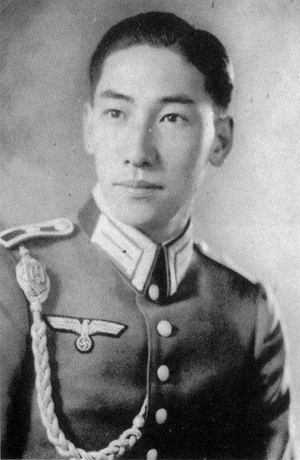Honorary Racial Status
Where they found it convenient, leaders of the Third Reich made exceptions for extremely select persons that didn’t fit their blood purity laws. They were given Hitler-signed “Honorary Aryan” letters.
Roughly 100,000 part-Jewish men were in the Wehrmact. One can only imagine the different ways they reasoned and reconciled their heritage and identity throughout the war.
Many of these Jews believed the Nuremburg racial laws and the rising tide of anti-Semitism did not apply to them. They were not Ostjuden, whom they perceived as uneducated and superstitious. German Jews were cultured. They were patriotic.
…A half-Jewish officer, whose maternal grandparents had converted to Christianity …learned about his Jewish ancestry only at the age of 18 when his mother confessed. He felt as if his entire world had been turned upside down. Previously confident of himself and his heritage, he suddenly felt like a member of an inferior species.
Ellen Feldman, “The Jews Who Fought for the Nazis”, Tablet, August 5, 2020.

Helmut Wilberg, State Secretary of the German Airforce, was discovered to be a “first-degree Misclinge” but declared Aryan in 1935 by Hitler through the insistence of Hermann Göring.

Helene Mayer, had fled to the US but took part in the Olympics representing Germany in 1936

Caption: Palestinian Amin al-Husseini and Mufti of British Mandated Palestine was deemed an honorary Aryan
The Japanese (and for a minute, the Chinese) were also declared honorary Aryans.
Historian Gerhard Krebs recounts the tense diplomatic dance between the Nazi regime and Japanese government:
"On 11 October 1933, the Japanese Ambassador to Berlin, Nagai Matsuzō, visited State Secretary of the Foreign Ministry (deputy minister), Bernhard Wilhelm von Bülow, demanding clarification and stressing that the Japanese public could become hostile to Germany judging from their bad experience with racism in America. von Bülow tried to explain that the German prejudice was only directed towards the mixing of races, since mixed races were considered to be of lower value. His government, however, would be especially careful in avoiding any misunderstandings concerning the expressions criticized by Nagai.
About ten days later, the Japanese Ambassador held an interview with Foreign Minister Konstantin von Neurath, once again asking if the term “colored” applied to the Japanese too and if it prohibited Japanese-German marriages. According to foreign sources, von Neurath answered that the term “colored” did not apply to the Japanese. Several days after Nagai’s interviews in the Foreign Ministry, a Japanese girl, the Sumitomo combine representative’s daughter, was mistreated and referred to as “colored” by German youngsters. The subsequent outcry in the Japanese press led to a great deal of embarrassment and resulted in a protest filed by Ambassador Nagai and a subsequent apology from Foreign Minister Konstantin von Neurath."
–from “Racism under Negotiation: The Japanese Race in the Nazi-German Perspective”, Race and Racism in Modern East Asia, Volume: 4, Jan 1 2015.

Chiang Wei-kuo of the Chinese Nationalist Party as Fahnenjunker in the Wehrmacht, 1938. A Sino-German peace treaty signed in 1921 laid a groundwork for military and economic exchange during the interwar years for Germany and the civil war era in China.
Footnotes
Jason Dawsey, “Adolf Hitler and the Origins of the Berlin-Tokyo Axis”, National WWII Museum of New Orleans, November 3, 2021 ****https://www.nationalww2museum.org/war/articles/adolf-hitler-and-origins-berlin-tokyo-axis